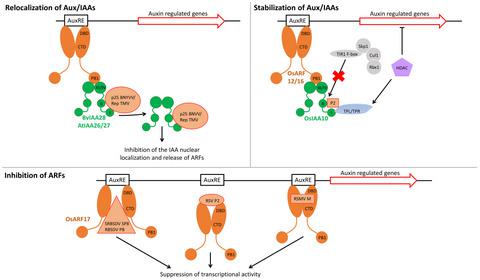当前位置:
X-MOL 学术
›
Mol. Plant Pathol.
›
论文详情
Our official English website, www.x-mol.net, welcomes your
feedback! (Note: you will need to create a separate account there.)
Manipulation of auxin signalling by plant viruses
Molecular Plant Pathology ( IF 4.8 ) Pub Date : 2021-08-21 , DOI: 10.1111/mpp.13122 Maximilian Müllender 1 , Mark Varrelmann 1 , Eugene I Savenkov 2 , Sebastian Liebe 1
Molecular Plant Pathology ( IF 4.8 ) Pub Date : 2021-08-21 , DOI: 10.1111/mpp.13122 Maximilian Müllender 1 , Mark Varrelmann 1 , Eugene I Savenkov 2 , Sebastian Liebe 1
Affiliation

|
Compatible plant–virus interactions result in dramatic changes of the plant transcriptome and morphogenesis, and are often associated with rapid alterations in plant hormone homeostasis and signalling. Auxin controls many aspects of plant organogenesis, development, and growth; therefore, plants can rapidly perceive and respond to changes in the cellular auxin levels. Auxin signalling is a tightly controlled process and, hence, is highly vulnerable to changes in the mRNA and protein levels of its components. There are several core nuclear components of auxin signalling. In the nucleus, the interaction of auxin response factors (ARFs) and auxin/indole acetic acid (Aux/IAA) proteins is essential for the control of auxin-regulated pathways. Aux/IAA proteins are negative regulators, whereas ARFs are positive regulators of the auxin response. The interplay between both is essential for the transcriptional regulation of auxin-responsive genes, which primarily regulate developmental processes but also modulate the plant immune system. Recent studies suggest that plant viruses belonging to different families have developed various strategies to disrupt auxin signalling, namely by (a) changing the subcellular localization of Aux/IAAs, (b) preventing degradation of Aux/IAAs by stabilization, or (c) inhibiting the transcriptional activity of ARFs. These interactions perturb auxin signalling and experimental evidence from various studies highlights their importance for virus replication, systemic movement, interaction with vectors for efficient transmission, and symptom development. In this microreview, we summarize and discuss the current knowledge on the interaction of plant viruses with auxin signalling components of their hosts.
中文翻译:

植物病毒对生长素信号的操纵
相容的植物-病毒相互作用导致植物转录组和形态发生的巨大变化,并且通常与植物激素稳态和信号传导的快速改变有关。生长素控制植物器官发生、发育和生长的许多方面;因此,植物可以快速感知并响应细胞生长素水平的变化。生长素信号是一个严格控制的过程,因此极易受到其成分的 mRNA 和蛋白质水平变化的影响。生长素信号传导有几个核心核成分。在细胞核中,生长素反应因子 (ARFs) 和生长素/吲哚乙酸 (Aux/IAA) 蛋白的相互作用对于控制生长素调节途径至关重要。Aux/IAA 蛋白是负调节剂,而 ARF 是生长素反应的正调节剂。两者之间的相互作用对于生长素反应基因的转录调节至关重要,生长素反应基因主要调节发育过程,但也调节植物免疫系统。最近的研究表明,属于不同家族的植物病毒已经开发出各种策略来破坏生长素信号传导,即通过(a)改变 Aux/IAAs 的亚细胞定位,(b)通过稳定化防止 Aux/IAA 降解,或(c)抑制ARF 的转录活性。这些相互作用扰乱了生长素信号传导,来自各种研究的实验证据强调了它们对病毒复制、全身运动、与载体相互作用以实现有效传播和症状发展的重要性。在这篇微评中,
更新日期:2021-10-15
中文翻译:

植物病毒对生长素信号的操纵
相容的植物-病毒相互作用导致植物转录组和形态发生的巨大变化,并且通常与植物激素稳态和信号传导的快速改变有关。生长素控制植物器官发生、发育和生长的许多方面;因此,植物可以快速感知并响应细胞生长素水平的变化。生长素信号是一个严格控制的过程,因此极易受到其成分的 mRNA 和蛋白质水平变化的影响。生长素信号传导有几个核心核成分。在细胞核中,生长素反应因子 (ARFs) 和生长素/吲哚乙酸 (Aux/IAA) 蛋白的相互作用对于控制生长素调节途径至关重要。Aux/IAA 蛋白是负调节剂,而 ARF 是生长素反应的正调节剂。两者之间的相互作用对于生长素反应基因的转录调节至关重要,生长素反应基因主要调节发育过程,但也调节植物免疫系统。最近的研究表明,属于不同家族的植物病毒已经开发出各种策略来破坏生长素信号传导,即通过(a)改变 Aux/IAAs 的亚细胞定位,(b)通过稳定化防止 Aux/IAA 降解,或(c)抑制ARF 的转录活性。这些相互作用扰乱了生长素信号传导,来自各种研究的实验证据强调了它们对病毒复制、全身运动、与载体相互作用以实现有效传播和症状发展的重要性。在这篇微评中,











































 京公网安备 11010802027423号
京公网安备 11010802027423号